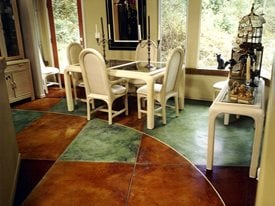If you’re trying to decide if staining your own concrete is something you can do, make sure you’ve done your homework. Staining concrete is not as easy or as forgiving as staining wood, but that doesn’t mean it is impossible.
IS IT HARD TO STAIN CONCRETE?
Overall, staining concrete can look like a simple process. However, it is important to keep in mind that while your stain is permanent, so are your mistakes.
Like many DIY projects, the steps are pretty simple to follow, and the list of tools required is fairly basic (sprayer, goggles, pressure washer, shop vacuum, etc.).
See the basic 4 step process below:
- Clean and prepare the surface
- Apply the stain
- Clean up and neutralize the stain
- Seal the concrete
Learn more about the staining process.
However, there are several things that can go wrong. The fact that stain is permanent also means that mistakes are permanent. "Even staining specialists with years of experience can encounter problems from time to time," says Chris Sullivan, vice president of sales and marketing for ChemSystems Inc. When applying stain to either new or existing concrete, understanding the basics — from surface prep to final sealing — are vital to a successful outcome.
If you have any doubts, especially if the slab is large, requires extensive surface preparation, or incorporates multiple colors and elaborate decorative effects, you should hire the services of an expert.
7 REASONS TO THINK TWICE ABOUT STAINING YOUR OWN CONCRETE
If you are still thinking about committing to DIY concrete staining, here are a few reasons this project might be best left to the pros:
Tools
The tools for staining are fairly basic, although acid stains will require acid-resistant brushes and spray equipment. The difficulty comes in knowing how to apply the stain correctly with those tools. Applying stains with mops, rollers and squeegees should only be done by experienced contractors because they can leave undesirable roller marks or streaks of color.Surface prep
Whether you’re staining new or old concrete, thorough surface preparation is essential. New concrete must be fully cured before applying stain, and existing concrete can present any number of problems depending on its exposure to weather, spills or chemicals and the type of wear it has received. Unlike paints and coatings which are opaque and can mask many evils, acid stains are translucent. Any residue remaining on the surface of the concrete is likely to be visible through the stain.
When done properly, surface preparation dramatically impacts the finished appearance of the project, and can affect it just as dramatically if done incorrectly. Surfaces can be prepped in two ways, either by mechanical grinding or with the use of a specially formulated cleaner. However, cleaning concrete with muriatic acid (acid washing) before acid staining depletes the lime in the concrete, preventing acid stains from reacting properly and producing the desired color. Knowing the best prep method for your project is critical.Product knowledge
Acid-based stains have different requirements than water-based stains for surface preparation, application and cleanup. Acid stains react chemically with the concrete and create a permanent chemical bond. Other, non-reactive, stains produce color by bonding to the concrete surface, filling the pores of the concrete and producing a colored film or coating. Before starting your project, you’ll need to know which type of stain is better suited for your application.Chemicals
When working with acid-based chemical stains, it’s important to be aware of proper precautionary measures as they often contain corrosive components that can cause eye and skin irritation and produce strong odors. This should also be taken into consideration when deciding between acid- and water-based stains. There are applications, such as enclosed basements and locations without proper ventilation, where water-based stains should be used because of the chemical exposure.Stain is permanent
Keep in mind that once the stain is down, the color is permanent and there's no going back. Color samples should always be done on the concrete you plan to stain to get a truer representation of how that particular surface will take the stain. Unlike paint, stains penetrate the surface, making future color changes quite difficult. Surrounding areas must be carefully masked off to avoid unintentional staining since acid stains can be tough and sometimes impossible to remove. Be careful when masking, because adhesive from tape may pull color off concrete that has already been stained or leave behind a residue that prevents the stain from reacting properly with unstained concrete.Compatibility and sealers
Stained concrete should be sealed for protection. Sealers will vary based on their compatibility with the stain that is used. Acid-based stains require residue to be removed and the surface to be neutralized with T.S.P., baking soda or ammonia before sealers can be applied. If this is not done properly, your sealer won’t be able to form a proper bond with the concrete.Conditions
Ambient conditions such as temperature, humidity and air flow can affect the drying and curing times.
If you’re still convinced this is a job you want to take on, here’s more information on How To Stain Concrete.
HOW MUCH DOES IT COST TO STAIN CONCRETE YOURSELF?
Staining concrete on your own can cost an average of $170 for a 500 sq. ft. area. That comes to about $0.34 per sq. ft. While you’ll only pay for materials and supplies, if you make a mistake it could be costly to fix. Staining is a permanent treatment for your concrete, and any mistakes will also be permanent. This is why hiring a contractor near you is always recommended. They will be able to finish on time, on budget and without error.
WHAT KIND OF STAINS ARE EASIEST TO USE?
When looking to stain your concrete, you have a couple of stain types to choose from, acid-based and water-based stains. While both types of stains penetrate the concrete surface for permanent coloring, there are a few differences in what they offer and how easy they are to use.
Most acid stains come in a palette limited to earthy tones, such as tans, browns, terra cottas and soft blue-greens. They can be a bit tricky for DIYers because they require special safety gear and neutralization to stop the reaction.
If you want to go beyond the subtle drama and subdued earth-toned palette of acid staining, consider using water-based stains, which come in a much broader spectrum of hues. You may find these more DIY-friendly because they are non-toxic and don’t require neutralization or rinsing.
Find concrete stains from leasing manufacturers.
Tip: Because stains must be able to soak into the concrete to achieve full color saturation, they shouldn't be applied to surfaces covered by anything that can inhibit stain penetration, such as dirt, grease, glues, coatings, curing membranes and sealers.
INDOOR VS. OUTDOOR STAINING
There are a few questions that you should consider asking when having your indoor floors or outdoor spaces stained. In either instance it is important that you use a good sealer to protect the stain. This will make sure that your surface lasts for a long time. Below is a list of questions to consider when getting ready to stain your concrete.
Indoor Staining
- Is the stain safe for indoor use?
- What are the cleanup requirements?
- What look are you trying to achieve?
- Is your floor slab emitting moisture?
Outdoor Staining
- Is the stain UV- and abrasion-resistant?
- Will acid stain kill vegetation and grass when used outdoors?
- Does the color work with your landscape and home exterior?
Related information:
Video: Pump-Up Sprayers for Applying Acid StainsTroubleshooting Common Acid Stain Problems
How to Fix Acid Stain Problems
DIY Concrete Patio

